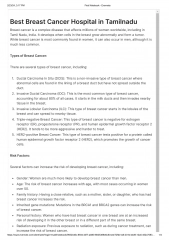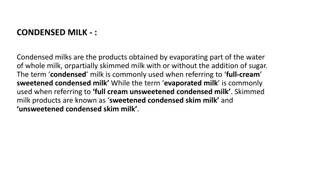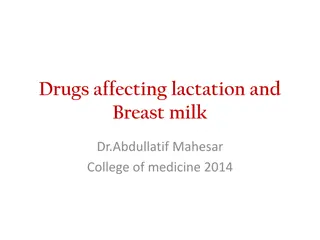The Impact of Breast Milk on School Performance: A Comprehensive Analysis
Breast milk plays a crucial role in brain development, cognitive abilities, and school performance in children. The quality and composition of breast milk are tailored to meet the specific needs of each mammal, including humans. Research indicates that children who receive proper nutrition, including breast milk, are more likely to perform well academically and exhibit enhanced cognitive skills. Chronic malnutrition, especially in early childhood, has a lasting impact on brain development and academic achievement. Understanding the benefits of breast milk is essential for promoting optimal growth and development in children.
Download Presentation

Please find below an Image/Link to download the presentation.
The content on the website is provided AS IS for your information and personal use only. It may not be sold, licensed, or shared on other websites without obtaining consent from the author. Download presentation by click this link. If you encounter any issues during the download, it is possible that the publisher has removed the file from their server.
E N D
Presentation Transcript
BREAST MILK AND SCHOOL PERFORMANCE By Mrs Latifat Busari-Ajisafe @ ADEOYO MATERNITY TEACHING HOSPITAL IBADAN
Outline Introduction Breast Milk Benefits of breast milk Recommendation for breast milk Role of the Human brain Human brain development Timeline School performance Macronutrients and brain development Micronutrients and brain development Conclusion References 18/08/2015
INTRODUCTION Early life of mammals is enriched by milk. The breast milk varies in composition from one animal to the other. Growing evidences shows that the quality of each mammalian breast milk is adequate for the capability and functionality of their brains. For example the casein-dominated milk of cow is adequate to nourish the brain for grazing while human whey-dominated milk is necessary to coordinate higher reasoning and functioning. 18/08/2015
An estimated 200 million children under age five in low- and middle-income countries are at risk of failing to reach their developmental potential in cognitive, motor, and socio-emotional abilities, partly due to undernutrition. Chronic malnutrition, as measured by poor physical growth, is also associated with reduced cognitive and motor development. From the first year of life through school age, children who are short for their age (stunted) or underweight for their age perform more poorly than their normal-sized peers (on average) in cognitive and motor tasks and in school achievement. 18/08/2015
Longitudinal studies have also consistently shown that children who had been stunted (height for age < -2 SD below norm values) in the first 2 years of life continued to show deficits in cognition and school achievement from age 5 years to adolescence. This, chronic undernutrition in early life seems to have long-lasting consequences development. for brain 18/08/2015
Breast Milk Just the right amount of nutrients in the right proportions Over 200 components in human milk Human milk has more than 200 constituents, including protein, fat, carbohydrates, vitamins, and minerals, as well as components such as hormones, growth factors, antibodies, enzymes, and live cells. The composition of human milk is a delicate balance of macronutrients and micronutrients, each in the proper proportion to enhance absorption. 18/08/2015
The Benefits of Breast Milk Beyond providing essential nutrition, human milk confers many other benefits: infection in the infant by providing antibodies and other immunologic factors. 1. Enhanced Immunity. Human milk can help prevent suggest that breastfeeding may reduce the incidence of insulin- dependent (type 1) and non insulin-dependent(type 2) diabetes mellitus, lymphoma, leukemia, and Hodgkin disease, obesity, hypercholesterolemia, and asthma in later childhood and adulthood. 3 2. Protection Against Chronic Disease. Some studies 18/08/2015
The Benefits of Breast Milk Contd 3. Enhanced Gastrointestinal Function. Many factors in human milk may stimulate gastrointestinal growth and motility and enhance maturity of the gastrointestinal tract. associated with slightly enhanced performance on tests of cognitive development. 5.Enhanced Maternal Health. Breastfeeding decreases postpartum bleeding, facilitates more rapid uterine involution, promotes an early return to pre-pregnancy weight, decreases the risk of breast and ovarian cancers, and possibly decreases the risk of hip fractures and osteoporosis after menopause. 3 4. Enhanced Neurodevelopment. Breastfeeding has been 18/08/2015
Breast Milk Recommendation Human milk is the preferred source of nutrition for infants and numerous experts recommend infants to be exclusively breastfed for the first six months of life. Exclusive breast feeding until 6 months of age Introduce complimentary foods with continued breastfeeding Optimum to breastfeed for 2 years or longer 18/08/2015
School Performance The brain develops its structural form and functional capacity through dynamic bidirectional influences between biological factors (such as nutrition), genetic factors, the child s experiences, and the child s own behaviour. Several studies have found that nutrition and psychosocial stimulation together result in greater improvements in child development than either intervention alone. 18/08/2015
School Performance Pregnancy and infancy are important periods for the formation of the brain, laying the foundation for the development of cognitive, motor, and socioemotional skills throughout childhood and adulthood. Children with restricted development of these skills during early life are at risk for later neuropsychological problems, poor school performance, early school drop- out, low-skilled employment, and poor care of their own children, thus contributing to the intergenerational transmission of poverty 18/08/2015
Estimated percentage of children under 5 failing to fulfil their developmental potential by country in 2004. Grantham-McGregor et al. (2007) 18/08/2015
Macronutrient and brain development CARBOHYDRATE: this is lactose predominantly in human milk. 7% concentration provides up to 40% caloric needs. Lactose, a disaccharide, is composed of 2 simple sugars: glucose and galactose. Glucose and galactose are used by the body for energy. Essential for development of CNS. Galactose is also used for the formation of myelin, the protective sheath that surrounds the nerve fibres. In large intestine, lactose provides an acidic environment that promotes the growth of protective bacteria (lactobacilli) and suppresses disease-causing bacteria. Enhances calcium and iron absorption 18/08/2015
PROTEIN: Digestion of protein provides energy and amino acids. Amino acids are the buildingblocks vital for synthesizing enzymes, antibodies, hormones, and other proteins in the body. Nonessential amino acids can be manufactured by the infant, usually from the essential amino acids In addition, some amino acids, such as cystine/cysteine and tyrosine, are considered essential for preterm and young infants. Therefore, unless they are supplied in the infant s diet, they may be in inadequate supply. The newborn may also be unable to make enough taurine, an amino acid derived from cystine/cysteine. Breast milk contains considerable amounts of taurine. Taurine is important for fat digestion and nerve development 18/08/2015
FAT: 4% concentration provides up to 50% of caloric needs, cholesterol level constant, lipolytic enzymes aid in fat digestion. the fat in human milk is well absorbed and provides appropriate amounts of essential fatty acids A significant amount of the phospholipid in the cerebral cortex of the brain consists of long-chain polyunsaturated fatty acids (LCPUFAs), primarily AA and DHA. The presence of small, but significant, levels of AA and DHA in breast milk indicates their importance to the infant. Clinical trials have shown that plasma and red blood cell lipid levels of DHA are higher in breastfed infants than in infants fed unsupplemented formula. 18/08/2015
*Sources of LC-PUFAs human breast milk Green leafy vegetables Fenugreek seeds Kidney beans Highly refined oil from single cell organism (e.g algae and fungi ) Fish oil e.g. salmon, herring, bunito, marcrel, halibut, mussels, lobsters certain vegetable oils like linseed oil, canola oil, peanut oil, olive oil, soya oil, and walnut oil. eggs, seaweed e.g. red algae. 18/08/2015
LC-PUFAs and Brain development 1 Two-thirds of human brain weight is made up of phospholipids DHA Docosahexanoic acid - is an important component of phospholipids - an adequate content in diet is crucial for brain development - is made from Essential fatty acids - is the most abundant fatty acid in the brain (40%) and retina (60%). - Fatty acids make up around 20% of dry brain mass, and affect brain growth and connectivity - along with AA, it is an LC-PUFA -Both are key structural components of neuronal membranes. 18/08/2015
FAT: Research also indicates that breastfed infants have higher DHA levels in the brain than do infants fed formula lacking DHA AA is a precursor of prostaglandins, substances that have a diversity of roles in modulating intercellular and intracellular responses. DHA appears to have a role in neurologic and visual development. Breastfed infants perform better on visual acuity tests and psychomotor tests than do infants fed infant formula devoid of AA and DHA. 18/08/2015
Improved Visual Acuity After Feeding LC- PUFA enriched Weaning Foods 18/08/2015
DHA in Infancy Improved Visual Acuity at 4 Years (Right Eye) 0.10 0.09 0.08 0.07 0.06 logMAR 0.05 0.04 0.03 0.02 0.01 0.00 Control DHA DHA + ARA BF 18/08/2015
Micronutrient and brain development Micronutrient deficiency is a critical concern for mothers and children throughout the world. 25% of the world s population suffer from iron deficiency anaemia, 33% have insufficient zinc intake, and 30% have inadequate iodine intake. Each of these micronutrients is involved in brain development, and deficiencies are likely to impair cognitive, motor, and socio-emotional abilities. 18/08/2015
IRON Iron-deficiency anaemia is associated with poor mental and motor development in infancy and poor cognition and school achievement in later childhood. Longitudinal studies have also consistently demonstrated that children who had been anaemic in the fist 2 years of life continued to show deficits in cognition and school achievement from 4 to 19 years of age However, another randomized trial in an area in Nepal with a high prevalence of iron deficiency anaemia indicated that children whose mothers had received iron, folic acid, and vitamin A performed better than those whose mothers had received vitamin A alone on tests of non-verbal intelligence, executive function, and motor ability at 7 to 9 years of age. 18/08/2015
IODINE Even in the absence of overt cretinism, the evidence is strong that chronic iodine deficiency negatively affects intelligence. A meta-analysis showed a 13.5 IQ point difference between individuals living in iodine-sufficient and iodine-deficient areas. Another more recent meta-analysis of studies in China indicated a similar estimate of 12.5 IQ points. Adequate iodine intake is clearly necessary for normal brain development. Prevention of iodine deficiency, especially for pregnant mothers, is an important way to promote healthy brain development in children worldwide 18/08/2015
ZINC Zinc is the fourth most abundant ion in the brain, where it contributes to brain structure and function through its role in binding proteins. Although animal models have shown that maternal and infant zinc deficiency causes deficits in activity, attention, learning and memory The evidence to date in humans has not shown benefits of zinc supplementation during pregnancy or infancy on child cognitive development. 18/08/2015
THIAMINE Like zinc, thiamine is important for brain development and function through many mechanisms, including its role in carbohydrate metabolism (which helps to provide the brain s energy supply), membrane structure and function, and synapse formation & function. Thiamine-deficiency disorders are typically characterized by neurological symptoms. A recent study in Israel demonstrated deficits in language abilities in 5-7 year olds who had been fed a thiamine-deficient formula during infancy. It is suggested that thiamine deficiency and its effects on brain development may affect many children without being detected. 18/08/2015
Others Folate (B9) - prevents neural tube defect Remains at same level through all stages of lactation Cobalamine (B12) crucial for neuronal development exclusively obtained from animal products Vitamin C - prevents scurvy, antioxidant, collagen synthesis, neurotransmitter synthesis Inositol & Choline - cell membranes & signalling 18/08/2015
WATER ~90% of breast milk is made of water. Therefore, breast milk provides all the water a baby needs. 18/08/2015
CONCLUSION Preventing these conditions should be our priority: Severe acute malnutrition (low weight for height) Chronic undernutrition (as evidenced by intra- uterine growth retardation and linear growth retardation or stunting) Iron-deficiency anaemia Iodine deficiency 18/08/2015
CONCLUSION However, additional robust research in low- and middle-income countries that evaluates the long- term effects of these interventions is needed. Supplementation with iron and folic acid and/or multiple micronutrients during pregnancy Provision of multiple micronutrients (in addition to iron) during infancy Supplementation with essential fatty acids during pregnancy and infancy Fortified food supplements provided during pregnancy and infancy 18/08/2015
CONCLUSION Children who do not receive adequate nutrition are at risk for failing to reach their developmental potential in cognitive, motor, and socio-emotional abilities. The development of these abilities is linked to academic achievement and economic productivity. All children should have the opportunity to fulfil their developmental potential. Integrated interventions targeting multiple risk factors, including nutrition, are necessary to reduce inequality and promote cognitive, motor, and socio-emotional development in disadvantaged children worldwide. 18/08/2015























